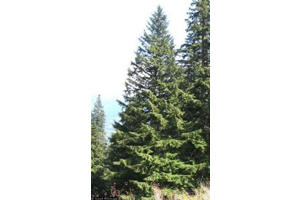The wood of western hemlock has been used for carving spoons, combs, and dishes, and is commonly used today for making doors, windows, parts of staircases, ladders, and other architectural millwork items.
Photo Credit: © Susan McDougall, USDA-NRCS PLANTS Database.
Tsuga heterophylla
Common Name: western hemlock
Other Common Names: Pacific hemlock, west coast hemlock
Plant Functional Group: Evergreen conifer
Class > Order > Family: Pinopsida > Pinales > Pinaceae
What does the species look like?
Western hemlock is an evergreen, coniferous tree growing to 200 feet tall, sometimes more. Male and female cones are present on the same tree. Cone production begins when the tree matures at about 25 to 30 years of age, sometimes as early as 10 years of age. The tiny, yellow male cones bear pollen, and the female cones start as greenish to reddish-purple and mature to golden brown; they are are wind-pollinated.
Western hemlock thrives in a mild, humid climate. It will grow on soils derived from almost all parent materials within its range and on most soil textural classes. Under appropriate climatic conditions, it is able to thrive on all major landforms.
Where is the species found?
States & Provinces
AB, AK, BC, CA, ID, MT, OR, WA
Which phenophases should I observe?
Do you see...?
Needles
Breaking needle buds More...
How many buds are breaking?
Less than 3 3 to 10 11 to 100 101 to 1,000 1,001 to 10,000 More than 10,000
Young needles How many young needles are present?
Less than 3 3 to 10 11 to 100 101 to 1,000 1,001 to 10,000 More than 10,000
Pollen cones
Pollen cones More...
How many fresh pollen cones are present?
Less than 3 3 to 10 11 to 100 101 to 1,000 1,001 to 10,000 More than 10,000
Open pollen cones What percentage of all fresh pollen cones (unopened plus open) on the plant are open?
Less than 5% 5-24% 25-49% 50-74% 75-94% 95% or more
Pollen release More...
How much pollen is released?
Little: Only a few grains are released. Some: Many grains are released. Lots: A layer of pollen covers your palm, or a cloud of pollen can be seen in the air when the wind blows
Seed cones
Unripe seed cones Tsuga heterophylla , an unripe seed cone is green or brown with scales closed together.More...
How many seed cones are unripe?
Less than 3 3 to 10 11 to 100 101 to 1,000 1,001 to 10,000 More than 10,000
Ripe seed cones Tsuga heterophylla , a seed cone is considered ripe when it has turned brown and the scales have begun to spread apart to expose the seeds inside. Do not include empty cones that have already dropped all of their seeds.More...
How many seed cones are ripe?
Less than 3 3 to 10 11 to 100 101 to 1,000 1,001 to 10,000 More than 10,000
Recent cone or seed drop More...
How many seed cones have dropped seeds or have completely dropped or been removed from the plant since your last visit?
Less than 3 3 to 10 11 to 100 101 to 1,000 1,001 to 10,000 More than 10,000
What do these phenophases look like?
There is currently no photoguide available for this species. If you'd like help us create one, use the guidance document and species template provided here . Then send it via email to education@usanpn.org when it is complete.
